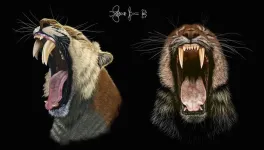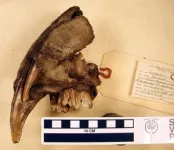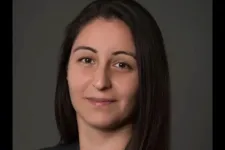(Press-News.org) The fearsome, saber-like teeth of Smilodon fatalis — California's state fossil — are familiar to anyone who has ever visited Los Angeles' La Brea Tar Pits, a sticky trap from which more than 2,000 saber-toothed cat skulls have been excavated over more than a century.
Though few of the recovered skulls had sabers attached, a handful exhibited a peculiar feature: the tooth socket for the saber was occupied by two teeth, with the permanent tooth slotted into a groove in the baby tooth.
Paleontologist Jack Tseng, associate professor of integrative biology at the University of California, Berkeley, doesn't think the double fangs were a fluke.
Nine years ago, he joined a few colleagues in speculating that the baby tooth helped to stabilize the permanent tooth against sideways breakage as it erupted. The researchers interpreted growth data for the saber-toothed cat to imply that the two teeth existed side by side for up to 30 months during the animal's adolescence, after which the baby tooth fell out.
In a new paper accepted for publication in the journal The Anatomical Record, Tseng provides the first evidence that the saber tooth alone would have been increasingly vulnerable to lateral breakage during eruption, but that a baby or milk tooth alongside it would have made it much more stable. The evidence consists of computer modeling of saber-tooth strength and stiffness against sideways bending, and actual testing and breaking of plastic models of saber teeth.
"This new study is a confirmation — a physical and simulation test — of an idea some collaborators and I published a couple of years ago: that the timing of the eruption of the sabers has been tweaked to allow a double-fang stage," said Tseng, who is a curator in the UC Museum of Paleontology. "Imagine a timeline where you have the milk canine coming out, and when they finish erupting, the permanent canine comes out and overtakes the milk canine, eventually pushing it out. What if this milk tooth, for the 30 or so months that it was inside the mouth right next to this permanent tooth, was a mechanical buttress?"
He speculates that the unusual presence of the baby canine — one of the deciduous teeth all mammals grow and lose by adulthood — long after the permanent saber tooth erupted protected the saber while the maturing cats learned how to hunt without damaging them. Eventually, the baby tooth would fall out and the adult would lose the saber support, presumably having learned how to be careful with its saber. Paleontologists still do not know how saber-toothed animals like Smilodon hunted prey without breaking their unwieldy sabers.
"The double-fang stage is probably worth a rethinking now that I've shown there's this potential insurance policy, this larger range of protection," he said. "It allows the equivalent of our teenagers to experiment, to take risks, essentially to learn how to be a full-grown, fully fledged predator. I think that this refines, though it doesn't solve, thinking about the growth of saber tooth use and hunting through a mechanical lens."
The study also has implications for how saber-toothed cats and other saber-toothed animals hunted as adults, presumably using their predatory skills and strong muscles to compensate for vulnerable canines.
Beam theory
Thanks to the wealth of saber-toothed cat fossils, which includes many thousands of skeletal parts in addition to skulls, unearthed from the La Brea Tar Pits, scientists know a lot more about Smilodon fatalis than about any other saber-toothed animal, even though at least five separate lineages of saber-toothed animals evolved around the world. Smilodon roamed widely across North America and into Central America, going extinct about 10,000 years ago.
Yet paleontologists are still confounded by that fact that adult animals with thin-bladed knives for canines apparently avoided breaking them frequently despite the sideways forces likely generated during biting. One study of the La Brea predator fossils found that during periods of animal scarcity, saber-toothed cats did break their teeth more often than in times of plenty, perhaps because of altered feeding strategies.
The double-fanged specimens from La Brea, which have been considered rare cases of individuals with delayed loss of the baby tooth, gave Tseng a different idea — that they had an evolutionary purpose. To test his hypothesis, he used beam theory — a type of engineering analysis employed widely to model structures ranging from bridges to building materials — to model real-life saber teeth. This is combined with finite element analysis, which uses computer models to simulate the sideways forces a saber tooth could withstand before breaking.
"According to beam theory, when you bend a blade-like structure laterally sideways in the direction of their narrower dimension, they are quite a lot weaker compared to the main direction of strength," Tseng said. "Prior interpretations of how saber tooths may have hunted use this as a constraint. No matter how they use their teeth, they could not have bent them a lot in a lateral direction."
He found that while the saber's bending strength — how much force it can withstand before breaking — remained about the same throughout its elongation, the saber's stiffness — its deflection under a given force — decreased with increasing length. In essence, as the tooth got longer, it was easier to bend, increasing the chance of breakage.
By adding a supportive baby tooth in the beam theory model, however, the stiffness of the permanent saber kept pace with the bending strength, reducing the chance of breaking.
"During the time period when the permanent tooth is erupting alongside the milk one, it is around the time when you switch from maximum width to the relatively narrower width, when that tooth will be getting weaker," Tseng said. "When you add an additional width back into the beam theory equation to account for the baby saber, the overall stiffness more closely aligned with theoretical optimal."
Though not reported in the paper, he also 3D-printed resin replicas of saber teeth and tested their bending strength and stiffness on a machine designed to measure tensile strength. The results of these tests mirrored the conclusions from the computer simulations. He is hoping to 3D-print replicas from more life-like dental material to more accurately simulate the strength of real teeth.
Tseng noted that the same canine stabilization system may have evolved in other saber-toothed animals. While no examples of double fangs in other species have been found in the fossil record, some skulls have been found with adult teeth elsewhere in the jaws but milk teeth where the saber would erupt.
"What we do see is milk canines preserved on specimens with otherwise adult dentition, which suggests a prolonged retention of those milk canines while the adult tooth, the sabers, are either about to erupt or erupting," he said.
Tseng is supported by the National Science Foundation's Division of Biological infrastructure (2128146).
END
The double-fanged adolescence of saber-toothed cats
Evidence suggests saber-toothed cats held onto their baby teeth to stabilize their sabers
2024-04-30
ELSE PRESS RELEASES FROM THIS DATE:
COVID-19-induced financial hardships reveal mental health struggles
2024-04-30
When COVID-19 caused significant economic disruptions, thousands of people around the world experienced sudden shocks to their financial situation through reduced earnings or job losses.
Now economic researchers at the University of South Australia have examined the mental health effects on people who experienced immediate or expected financial setbacks during the height of the pandemic.
Data gathered from China, Japan and South Korea during the early phases of the pandemic revealed that the severe economic shocks induced by COVID-19 caused significant ...
Healthy lifestyle may offset effects of life-shortening genes by 60%+
2024-04-30
A healthy lifestyle may offset the effects of life-shortening genes by more than 60%, suggests an analysis of the findings from several large long term studies, published online in the journal BMJ Evidence Based Medicine.
While genes and lifestyle seem to have an additive effect on a person’s lifespan, an unhealthy lifestyle is independently linked to a 78% heightened risk of dying before one’s time, regardless of genetic predisposition, the research indicates.
The polygenic risk score (PRS) combines ...
Frequent teen vaping might boost risk of toxic lead and uranium exposure
2024-04-30
Frequent teen vaping might boost the risk of exposure to lead and uranium, potentially harming brain and organ development, suggests research published online in the journal Tobacco Control.
The findings underscore the need for implementation of regulations and prevention efforts targeting teens, emphasise the researchers.
Vaping is popular with teens. In 2022, an estimated 14% of US high school students—around 2.14 million—and more than 3% of middle school students—around 380,000—reported vaping in the preceding month, note the researchers.
Certain metals have been identified in e-cigarette aerosols and ...
Fentanyl inhalation may cause potentially irreversible brain damage, warn doctors
2024-04-30
Inhaling the synthetic opioid fentanyl may cause potentially irreversible brain damage (toxic leukoencephalopathy), warn doctors in the journal BMJ Case Reports, after treating a middle aged man found unresponsive in his hotel room after snorting the drug.
Leukoencephalopathy refers to inflammation and damage to the brain’s white matter—the network of nerve fibres that enable the exchange of information and communication between different areas of the brain’s grey matter.
Toxic leukoencephalopathy is a sudden or longstanding neurological syndrome, which ...
OHSU patient is world’s first documented case of brain disease from fentanyl inhalation
2024-04-30
The man arrived unconscious and near death.
Previously healthy with no known medical history, the 47-year-old arrived by ambulance to the emergency department at Oregon Health & Science University on Feb. 25, 2023. He was found collapsed in his hotel room, where he was staying during a business trip. As clinicians began administering life-saving treatment, they searched for the cause.
In a case report published online today in the journal BMJ Case Reports, clinicians laid out the surprising and unprecedented diagnosis: toxic ...
Microarray patches safe and effective for vaccinating children, trial shows
2024-04-30
EMBARGOED UNTIL 23:30 UK TIME MONDAY 29 APRIL 2024
Peer-reviewed/Randomised Control Trial/Humans
The phase 1/2 randomized trial compared results from the measles and rubella vaccine delivered by a microarray patch, a small sticking plaster-like device with an array of microscopic projections that painlessly penetrate the skin and deliver the vaccine, or by conventional injection with a needle and syringe.
The trial, which involved 45 adults (18-40 years old), 120 toddlers (15-18 months old) and 120 infants (9-10 months old) in The Gambia, ...
Montana State scientists’ research on RNA editing illuminates possible lifesaving treatments for genetic diseases
2024-04-30
BOZEMAN – A team at Montana State University published research this week that shows how RNA, the close chemical cousin to DNA, can be edited using CRISPRs. The work reveals a new process in human cells that has potential for treating a wide variety of genetic diseases.
Postdoctoral researchers Artem Nemudryi and Anna Nemudraia conducted the research alongside Blake Wiedenheft, professor in the Department of Microbiology and Cell Biology in MSU’s College of Agriculture. The paper, titled “Repair of CRISPR-guided RNA breaks enables site-specific RNA excision ...
UC Irvine astronomers’ simulations support dark matter theory
2024-04-30
Irvine, Calif., April 29, 2024 — Computer simulations by astronomers support the idea that dark matter – matter that no one has yet directly detected but which many physicists think must be there to explain several aspects of the observable universe – exists, according to the researchers, who include those at the University of California, Irvine.
The work addresses a fundamental debate in astrophysics – does invisible dark matter need to exist to explain how the universe works the way it ...
Rensselaer researcher publishes groundbreaking study on labor market discrimination against transgender people
2024-04-30
In 2020, the United States Supreme Court ruled in Bostock vs. Clayton County that transgender people are legally protected from employment discrimination. This came at a time of increased visibility, but also of legal and social challenges to the rights of transgender individuals. Meanwhile, there has been very little study of labor market discrimination against them. Rensselaer researcher Billur Aksoy, Ph.D., has recently conducted an innovative survey of Americans’ attitudes toward transgender people in the workplace.
Her paper, “Understanding Labor Market Discrimination Against Transgender ...
What's new in transportation data at PSU?
2024-04-30
Portland State University's Transportation Research and Education Center (TREC) maintains two large, public transportation data lakes: PORTAL and BikePed Portal. The latest round of funding for PORTAL, in the amount of $1.6 million, was awarded in February 2024 and will cover PORTAL's activities through the next five years. BikePed Portal, too, recently received $100K for another year of funding, and both are the focus of some exciting innovations in transportation data.
The two centralized ...
LAST 30 PRESS RELEASES:
Strategic river sensors could have forewarned of Texas Camp flood disaster
Drone sampling of whale breath reveals first evidence of potentially deadly virus in Arctic
Roman soldiers defending Hadrian’s Wall infected by parasites, study finds
Pinochet’s prisoners were tormented with music but still found solace in it, a new book reveals
Fertility remains high in rural Tanzania despite access to family planning
AI-assisted device can improve autism care access
Kinetic careers
Uncovering how parasitic plants avoid attacking themselves to improve crop resistance
Nanoparticle vaccine strategy could protect against Ebola and other deadly filoviruses
Study finds brain care score can predict risk of stroke across racial groups
Key lung immune cells can intensify allergic reactions
Do hormones explain why women experience more gut pain?
New materials conduct ions in solids as easily as in liquids
Breakthrough of the Year: Renewable energy begins to eclipse fossil fuel-based sources
LLM use is reshaping scientific enterprise by increasing output, reducing quality and more
Introducing LightGen, a chip for ultra-fast, ultra-efficient generative AI
Astronomers see fireworks from violent collisions around nearby star
ACC/AHA issue new guideline on managing congenital heart disease in adults
Cosmic crash caught on camera
Is talented youth nurtured the wrong way? New study shows: top performers develop differently than assumed
Ants: An untapped resource in the development of antibiotics?
Archaeologists use AI to create prehistoric video game
Mitochondria migrate toward the cell membrane in response to high glucose levels
Tiny viral switch offers hope against drug-resistant bacteria
Most parents aware of early peanut introduction guidelines, but confused about details
HPV vaccine can protect against severe lesions of the vulva and vagina
Virtual care provision and emergency department use among children and youth
Quadrivalent HPV vaccine and high-grade vulvovaginal lesions
Insights into dry eyes gained from stem cell-derived tear glands
Researchers identify 166 human pluripotent stem cell lines available for use in clinical applications
[Press-News.org] The double-fanged adolescence of saber-toothed catsEvidence suggests saber-toothed cats held onto their baby teeth to stabilize their sabers



